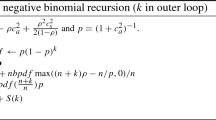Abstract
An iterative algorithm is developed for computing numerically the stationary queue length distributions in M/G/1/N queues with arbitrary state-dependent arrivals, or simply M(k)/G/1/N queues. The only input requirement is the Laplace-Stieltjes transform of the service time distribution.
In addition, the algorithm can also be used to obtain the stationary queue length distributions in GI/M/1/N queues with state-dependent services, orGI/M(k)/1/N, after establishing a relationship between the stationary queue length distributions inGI/M(k)/1/N and M(k)/G/1/N+1 queues.
Finally, we elaborate on some of the well studied special cases, such asM/G/1/N queues,M/G/1/N queues with distinct arrival rates (which includes the machine interference problems), andGI/M/C/N queues. The discussions lead to a simplified algorithm for each of the three cases.
Similar content being viewed by others
References
P.H. Brill and M.J.M. Posner, The system point method in exponential queues: a level crossing approach, Math. Oper. Res. 6 (1981) 31–49.
D.R. Cox, The analysis of non-Markovian stochastic processes by the inclusion of supplementary variables, Proc. Comb. Phil. Soc. (Math. and Phys. Sci.) 51 (1955) 433–441.
M.L. Chaudhry, U.C. Gupta and M. Agarwal, On exact computational analysis of distribution of numbers in systems forM/G/1/N+ 1 and GI/M/1/N + 1 queues using roots, Comp. Oper. Res. 8 (1991) 674–691.
P.J. Courtois and J. Georges, On a single-server finite queueing model with state-dependent arrival and service processes, Oper. Res. 19 (1971) 424–435.
D. Gross and C.M. Harris,Fundamentals of Queueing Theory, 2nd ed. (Wiley, New York, 1985).
U.C. Gupta and T.S.S. Srini Vasa Rao, A recursive method to compute steady state probabilities inM/G/1 machine interference model, submitted (1993).
W. Henderson, Alternative approaches to the analysis of theM/G/1 and G/M/1 queues, Oper. Res. 15 (1972) 92–101.
P. Hokstad, TheG/M/m queue with finite waiting room, J. Appl. Prob. 12 (1975) 779–792.
D.G. Kendall, Stochastic processes occurring in the theory of queues and their analysis by the method of the imbedded Markov chain, Ann. Math. Statist. 24 (1953) 338–354.
J. Keilson, Queues subject to service interruption, Ann. Math. Statist. 33 (1962) 1314–1322.
J. Keilson, The ergodic queue length distribution of queueing systems with finite capacity, J. Roy. Statist. Soc, Ser. B 28 (1966) 190–201.
M. Kijima and N. Makimoto, A unified approach toGI/M(n)/1/K and M(n)/GI/1/K queues via finite quasi-birth-death processes, Stoch. Models 8 (1992) 269–288.
L. Kleinrock,Queueing Systems, Vol. 1 (Wiley, New York, 1975).
M.F. Neuts,Matrix-Geometric Solutions in Stochastic Models —An Algorithmic Approach (Johns Hopkins Univ. Press, Baltimore, 1981).
H. Schellhaas, Computation of the state probabilities inM/G/l queues with state dependent input and state dependent service, OR spektrum 5 (1983) 223–228.
K.E. Stecke and J.E. Aronson, Review of operation/machine interference models, Int. J. Prod. Res. 23 (1985) 129–151.
L. Takács,Introduction to the Theory of Queues (Oxford University Press, New York, 1962).
P. Yang and Y. Zhu, On computational analysis ofM/G/1/C queues with exceptional first service time, submitted to Comp. Oper. Res. (1993).
Author information
Authors and Affiliations
Rights and permissions
About this article
Cite this article
Yang, P. A unified algorithm for computing the stationary queue length distributions inM(k)/G/1/N and GI/M(k)/1/N queues. Queueing Syst 17, 383–401 (1994). https://doi.org/10.1007/BF01158700
Received:
Revised:
Issue Date:
DOI: https://doi.org/10.1007/BF01158700



